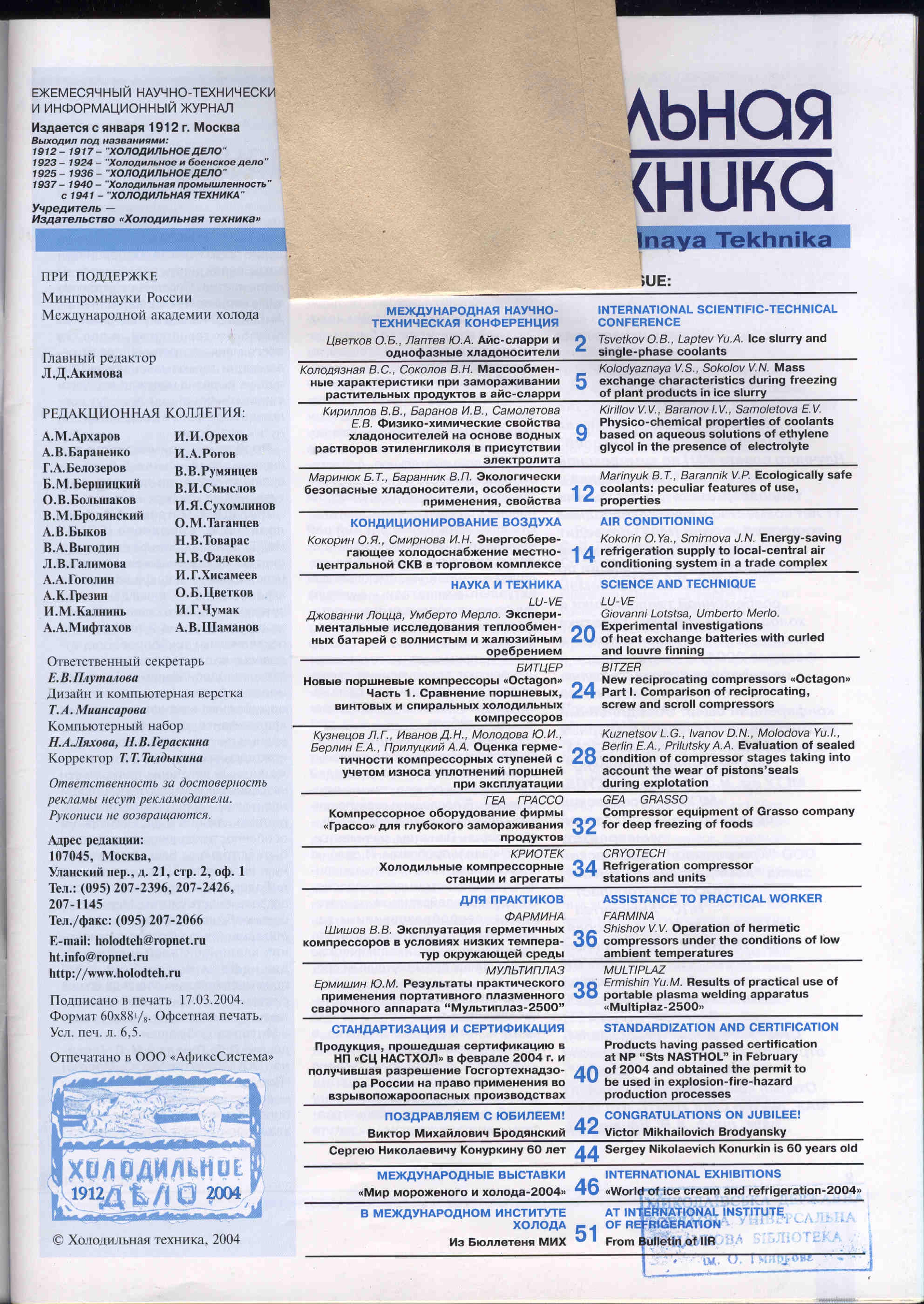Vol 93, No 3 (2004)
Articles
Ice slurry and single-phase coolants
Abstract
For more than 20 years at the beginning of the year, St. Petersburg State University of Low-Temperature and Food Technologies (SPbGUNiPT) together with the Working Group “Properties of Refrigerants and Heat Transfer Agents” of the Scientific Council of the Russian Academy of Sciences on the complex problem “Thermophysics and Thermal Power Engineering”, and for the last 11 years together with the International Academy Cold (MAX) holds traditional international conferences on topical issues of modern thermal physics and refrigeration technology. The theme of the last of them, held in February 2004, was "Ice-slurry and single-phase coolants." N.E. Bauman, MGUPB, MGUIE, Moscow State Regional University, Cryogenmash LLC, Moscow Compressor Plant, VNIHI, Spektroplast LLC, Khimsintez NPO, M.V. Lomonosov, CJSC TRANSAS Electronic Technologies, State Unitary Enterprise VNIPI of integrated energy technology, Airkul LLC, OK CJSC, St. Petersburg State Aviation Administration, JSC Kholodmash (Yaroslavl), industry magazines, including Refrigeration Technology. The conference was opened by the President of the Moscow Academy of Arts, Rector of St. Petersburg State University of Universities, Doctor of Engineering, Sciences, Prof. A.V. Baranenko.
 2-4
2-4


Mass transfer characteristics during freezing of vegetable products in ice slurry
Abstract
The paper is devoted to research of mass exchange characteristics vegetative products in perspective not boiling cold-carrying media — ice slurry. Absorption by a product of the refrigeration medium dissolved substances after various stages of processing are established. The quantity’ of acts of the freezing appropriate to increase cryoscopic temperature of medium on 1 Cis revealed. Increase of mass exchangefactor P at rising of medium speed is designed.
 5-8
5-8


Physical and chemical properties of coolants based on aqueous solutions of ethylene glycol in the presence of electrolyte
Abstract
Decrease in viscosity of the coolant based on aqueous solution of ethylene glycol when electrolytes are introduced into its composition is being investigated. The versions with different mass fractions of ethylene glycol (23,6—46,4) and electrolyte concentrations (0,04—0,75 mol/kg) have been considered. A technique of the experiment and results of determination of characteristics of all types of coolants are presented. It has been found that the least viscosity is achieved with the minimum of electrolyte concentrations tested.
 9-11
9-11


 12-13
12-13


Energy-saving refrigeration supply of local-central SCR in a shopping mall
Abstract
А refrigeration supply system of local-central air-conditioning system in a trade complex is described in detail. Energy saving is obtained through the use of refrigerating machines only in summer period. Daily fluctuations in refrigeration demand are traced by flexible system of automatic control of York refrigerating machines as used in the project. In winter period the AC system refrigeration demand is provided with cold outside air.
 14-18
14-18


 20-22
20-22


New piston compressors "Octagon". Part 1. Comparison of reciprocating, screw and scroll refrigeration compressors
Abstract
In the market for small displacement compressors for refrigeration and air conditioning applications, the trend is towards rotary compressors, while in low temperature refrigeration applications reciprocating compressors continue to be preferred. Increasing demands for energy efficiency, ease of use, the use of new environmentally friendly refrigerants intensify competition in this market sector. In this article, using the example of semi-hermetic reciprocating compressors of the new Octagon series, we would like to show how, with the help of simple technical solutions, it is possible to create products that meet the increased requirements of the modern market. First of all, let's consider some fundamental differences between reciprocating compressors and scroll and screw ones.
 24-26
24-26


Evaluation of the tightness of the compressor stages, taking into account the wear of the piston seals during operation
Abstract
Ал analytical expression was deduced for a conditional clearance determining the amount of leakage through piston sealing of the compressor, which allows to take into account the wear of rings during operation. An example is given for the calculation of leakage in I and II compressor stages of expander-compressor unit DKA 20-10/1C taking into account the wear of rings according to the offered technique. The technique allows to predict periodicity of rings change knowing the design and operating conditions of the stage.
 28-31
28-31


Operation of hermetic compressors at low ambient temperatures
Abstract
Practice shows that in winter, when operating a refrigeration unit located outside, compressors often fail due to broken valves or bearings. One of the reasons for such accidents is the unpreparedness of the unit for winter operating conditions.
 37-37
37-37


 38-39
38-39









